China # 5 – Along the Taklamakan Desert’s Northern Silk Road – September 2014
OK, so we can almost cross the Taklamakan Desert off our China Bucket List; amazing but thanks to the paved oil exploration road, not so bad. Given that without the road it would have lived up to its reputation, “The Sea of Death”.
We had to make a “few” miles every day because we still had lots to see in the next 21 days – 4,000 miles. Unfortunately, our route demanded that we stay on main highways, but in Korla we veered off on an interesting secondary road. It was certainly a slower pace and we had to constantly be aware of pedestrians and other drivers, both of whom operate with blinders on.
The Fat Man Noodle Restaurant
Green insisted that we stop at the Fat Man Noodle restaurant. Great idea! Green knew her Chinese food. Apparently, many towns are famous for something.
Taking a loop into the desert, we visited an old Uyghur village and the Jiache Ruins before continuing on to the larger ancient oasis of Goachang. This was a busy trading center and stopping point for merchant traders traveling on the Silk Road starting in the 1st century BC. It was destroyed in wars during the 14th century, but many ruins of this impressive and large city including the old palace can still be seen today. The standing walls and structures, now over 2,000 years old, were quite amazing. Bricks were apparently not used back then. The building technique was handfuls or buckets of mud one layer at a time and patted in place or formed into huge blocks. There are 77 known caves nearby that still have murals and tombs where nobles, officials, and others were interred.
Trouble in the Rear
Arriving in nearby Turpan early evening, there was no place to set up Green’s tent, so we found a cute hotel with a big parking area where we could relax and she could sleep and clean up. It was here that we discovered a major problem. The camper had been listing to the passenger side even though the Hellwig airbags were holding their 40 pounds of air pressure. Closer inspection showed that the shroud of the camper body was actually coming down and touching the airbag. The temporary solution was to take my Ingersoll-Rand air-powered reciprocal saw and grinder powered by our twin ExtremeAir Velocity compressors which feed our Viair 2.5-gallon aluminum reserve air tank to 125 psi. and trim the inner camper shroud off so that it no longer touched the airbag on bumps. Having the right tools for emergency repairs on a long overland trip can save the day. This was not the ultimate solution and we would not find out the real problem for several weeks.
- Back on the road, we crossed over a rocky range of low mountains and dropped back down into the Taklamakan desert.
- The long straight highways could be a bit boring.
- Some roadside color for a change. Locals were drying chilis right on the ground.
- We didn’t really get to choose but our Garmin GPS at least told us where we were, sort of.
- A short detour on a secondary road slowed our speed down and gave us a change of scenery.
- Our guide, Green, had learned about a place called the Fat Man Noodle restaurant.
- The process was interesting. While one guy cooked the handmade mile long noodles in a large pot of boiling water over a wood fire—–
- —-the second cook prepared a mixture of all kinds of vegetables and spices which he prepared in a wok.
- The spicy mixture was served in a separate bowl next to the noodles so the customer could mix as he chose.
- The noodles were delicious and I wanted to try them by themselves at first, eating them more like a dumb American.
- Monika got right into the business as she learned how to eat noodles the Chinese way. (She prefers the Italian way though with a spoon and fork.)
- Our chefs insisted on posing for a photograph with us outside.
- Wherever we stop, the map on The Turtle V fascinates people.
- You have all seen it before. Young kids always make the funniest photo opts.
- A young mother comforts her child, and you may notice there is no diaper. It’s the Chinese way.
- Our guide was getting really good at explaining to locals what our truck was all about.
- We soon came to our first tollgate. No problem, just pay money. There would be lots more.
- Back on the restrictive toll road, we were bordered and trapped by the steel guardrail and the nine-strand barbwire fence. We wondered, was it to keep us out or them in?
- One of the main local industries seemed to be based on fabricating reed mats for building homes or possibly for sand barriers in the desert.
- We saw variations of green houses along the highway, perhaps mainly to protect the plants from the searing heat of the summer and/or drying winds.
- The oasis Goachong on the northern edge of the Taklamakan Desert flourished from the 1st century BC to the 14th century AD when it was destroyed.
- This model of Guachang shows the impressive site of the ancient city along the northern Silk Road.
- The ancient city of Goachang was a busy trading center and stopping point for merchant traders traveling on the northern Silk Road.
- Goachang was destroyed in wars during the 14th century, but some of the 2,000-year-old buildings of the city had survived amazingly well.
- This wall held the remains of two Buddha figures.
- The building technique was one handful or bucket of mud one layer at a time and patted in place or formed into huge blocks.
- Sometimes it was good to get off the road for a coffee or tea break.
- Looks like Red Bull has made it to China.
- Major problem! The aluminum shroud of the camper had been touching one of our Hellwig suspension airbags on bumps.
- The immediate solution was to trim off part of the camper’s wheel well shroud with my small air-powered reciprocal saw.
- Our small air-powered Ingersoll-Rand air-powered reciprocal saw and grinder have proven their value more than once.
- Our twin ExtremeAir Velocity compressors, that feed our Viair 2.5-gallon aluminum reserve air tank, to 125 psi. have many uses; airing up tires, seating a tire bead, powering our Hellwig air bags, our Fiamm air horns, our front ARB Air Locker and just blowing off dust from cameras and other gear.



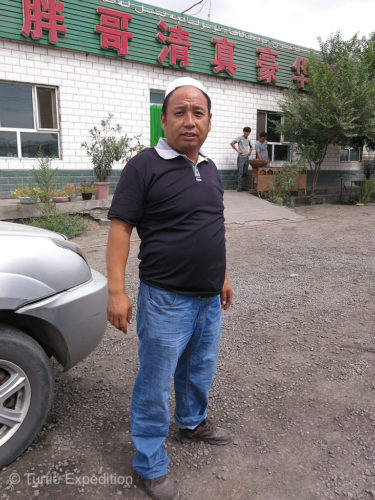
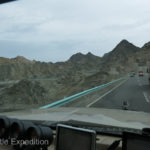
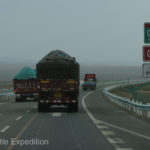
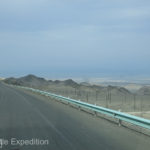
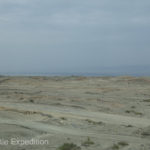
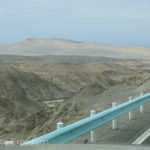
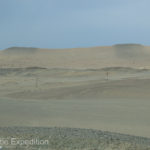
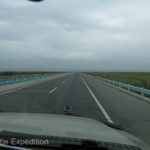
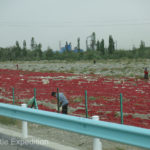
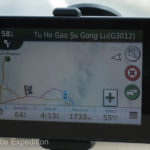
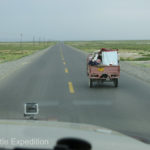
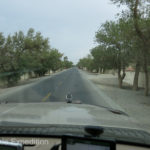
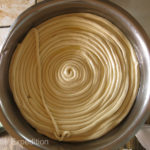
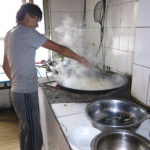
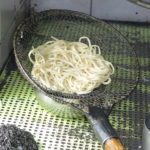
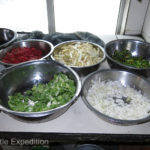
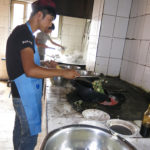
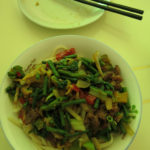
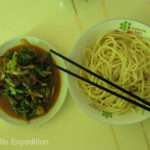
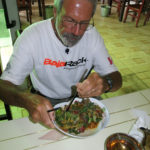
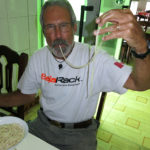
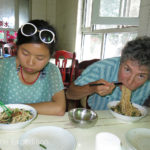
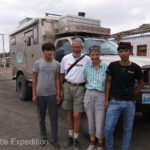
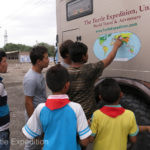
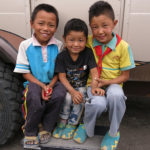
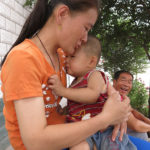
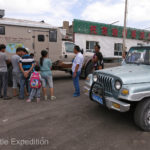
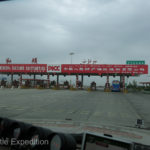
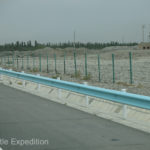
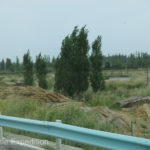
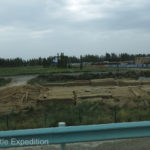
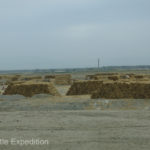
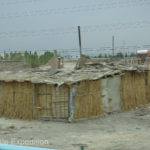
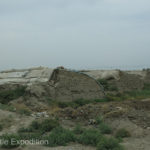
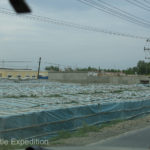
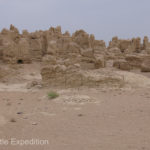
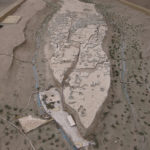
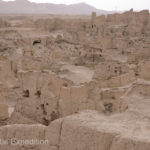
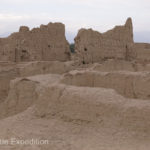
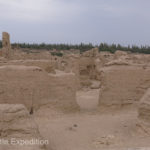
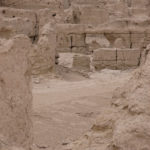
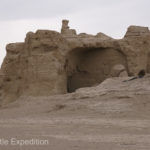
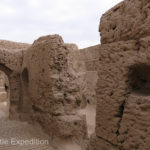
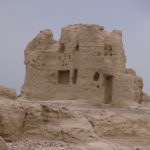
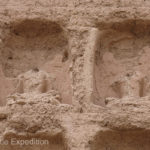
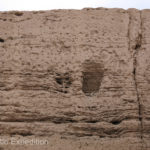
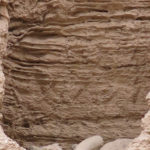
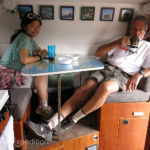
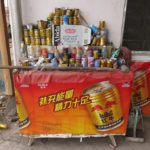
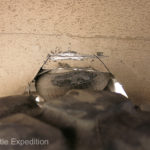
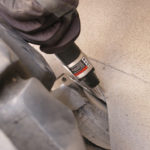
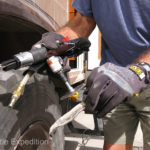
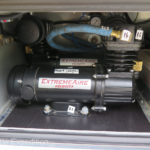





Your pictures, as always, are amazing. In the one picture it looks as if Gary is using the one chop stick to kill something in the bowl before starting to eat. Yes, the food looks great but the land looks harsh. The children as in so many of your pictures, look wonderful. Thanks for sharing, Ted
Airbag, I kept thinking this was a tire. I am glad you explain. I would like to know more about the dwelling made of fiber, that looks like straw.
The reed mat dwellings could have been temporary housing, storage or part of the green houses. We “flew” by there….